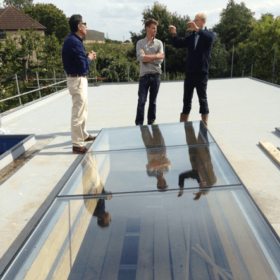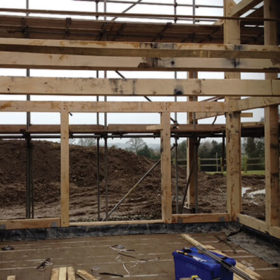
Learn from the experts with our online training course!
Use the code BUILD for 20% off
Learn from the experts with our online training course!
Use the code BUILD for 20% offI have been losing sleep over the sheer volume of decisions I need to make at the moment, particularly regarding our services. There is so much organising to do, whether it’s water or electricity, telephone or broadband, finding reliable information as to what the prerequisites are for connecting them is a black art.
I am at the foundation stage of the build and I now need to understand what the requirements are. Julia and I decided that the utility room would be the best location to have the services coming in, which was the easy bit.
The difficult aspects involve establishing the trench size/depth and bedding; knowing the ducting type and specifications required; what height from the ground floor the ducts can come in; where the ducting can be purchased; and where and how exactly within the wall structure the services terminate – for example, must it sit on the outside of the house, or can the cavity also be used? The list goes on.
Each utility connection differs from the other and from what I now understand, requirements between local authorities or service providers also vary. I believe this kind of information should be easily available – self builders seem to be forgotten by big utilities.
Given that we represent a small proportion of their connection workload, none of them have invested the time and energy to make the process simple and transparent – almost to the extent that out of frustration you feel like giving up and paying them to do the whole connection.
I have only just about got a handle on what to do: for the water we need to have a trench of between 50mm-1,000mm deep dug from ground level, and a blue duct should be installed. The electrics require a red duct terminating with a ‘hockey stick’ entry tube, which can be inside the cavity. And the trench for the electrics needs to be 450mm below ground.
Just when I thought I was getting to grips with all of this, I received a call from E.ON – I chose this supplier, based upon the time it claimed it could get a meter installed. The company informed me that it was no longer possible to connect on the given date and the next availability would be almost a week later.
This has had a significant impact on the project as I had already lined up some tradesmen to attend the site, and they would need electricity to do their work. We’d now have to go back to using noisy generators – and what’s worse is that our cordless drill batteries are not compatible with the flow of electricity that the generators emit.
I issued a complaint to E.ON and am appalled at the “computer says no” type of response I am receiving. I’ve been told that I will receive a £22 rebate in compensation, but I told them that it just won’t suffice. I have heard no more from them since. This whole episode fills me with dread as to what the performances of the next utility company will be like.
The only good news on the services front is that after some research, we have finally found the owner of the water supply we’d discovered on site (Severn Trent would not disclose the details to us). He is a nice elderly gentleman living just outside the village who had once used the field for grazing, and had a water supply put in to feed an animal trough. He was happy enough to relinquish the ownership, thank goodness.
I always knew that, because the site was at the foot of an incline, there was a likelihood of our plot getting a bit wet. I did not contemplate what a mudbath it would become, however. Ground conditions are a strange thing and somewhat unpredictable; we had to remove 400mm of vegetation to fulfil a watching brief and the accumulation of around 500m3 of soil is not easy to dispose of.
I did not want to get rid of this valuable top soil as I knew I would need it for landscaping later, but the mound we built up at the rear of the plot has collected storm water. This has taught me to be more forward thinking, as additional groundworks, plus stoning, will probably cost me £2,000.
I got a surprising email from our planning officer this week. I was initially perplexed as there were no conditions attached to our consent, so why was our officer making contact? I must have read it three times before coming to terms with the contents. A complaint has been submitted and the council has slapped a ‘restricted hours’ notice on the site.
The letter stated: “Please could you ensure that all developments that could impact on nearby residential dwellings have construction times restricted. Permitted hours of operation in the day (and also at weekends and Bank Holidays) are as follows: Monday-Friday 07:30-18:00, Saturdays 08:00-13:00, Sundays and Bank Holidays no construction activities.”
To us it’s fairly obvious that a complaint has been made, and the source of it. One of the more vociferous objectors to our planning application insisted during the last parish meeting (prior to planning being granted) that they would “complain about everything should the application be granted”.
The council hasn’t specified what the grievance was and we’ve just been given a generic ‘construction site’ type condition. As a self builder with a full time job and a passion to work on my own house, it’s going to be very difficult for me to do so in the evenings and at weekends.
I respect the need for peace and quiet especially on weekends, but if this project were a full-blown building site with multiple units and dozens of tradesmen on site maybe I could understand. We had already been making sure to keep things to a minimum on Sundays. For example, on the last one we worked, we only used the digger for a 30 minute period.
The government wants to support self builds, but why can’t local authorities get behind us, too? I only learned this week that Shropshire Council is not backing the initiative brought about by former housing minister Eric Pickles last November to exempt self builds from Section 106 fees. So it looks like it’s going to be a battle to the end! Self building really isn’t for the faint hearted.
In the next entry: The restricted hours order has slowed the progress of work on site. But Mark and Julia have managed to start erecting elements of their oak frame.

